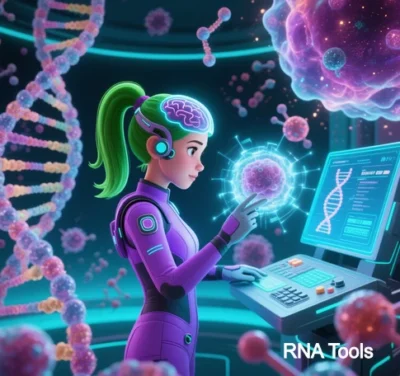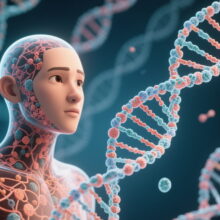
RNA Tools: Categories and Advances in Gene Editing Technologies
RNA tools have become pivotal in modern molecular biology and gene therapy, with their applications rapidly expanding. This review systematically categorizes RNA tools, highlights recent technological breakthroughs (as of May 2025), and explores their applications.
I. Core Categories of RNA Tools
1. RNA-Mediated Gene Regulation
- RNA Interference (RNAi):
- Mechanism: Degrades or inhibits mRNA translation via siRNA, shRNA, or miRNA.
- Applications: Gene functional studies, cancer therapy (e.g., targeting oncogenes).
- Antisense Oligonucleotides (ASOs):
- Mechanism: Modulates splicing (exon skipping/inclusion) or blocks translation via base pairing.
- Innovations: Chemical modifications (e.g., 2′-MOE, phosphorothioate) enhance stability and targeting.
2. RNA Editing Tools
- Single-Base Editors:
- A-to-I Editing: Uses ADAR enzymes (e.g., ADAR-dCas9 fusions) to correct point mutations (e.g., in Huntington’s disease).
- C-to-U Editing: RESCUE tools employ cytidine deaminases for metabolic disorder treatments.
- RNA-Targeting CRISPR Systems:
- Cas13 Family: Cas13a/d cleaves RNA viral genomes (e.g., SARS-CoV-2); Cas7-11 enables cut-free RNA regulation.
- CIRTS: Modular design reduces off-target effects.
3. mRNA Technology and Vaccine Platforms
- Therapeutic mRNA: Encodes antigens (e.g., Moderna’s COVID-19 vaccine) or functional proteins (e.g., clotting factors).
- Self-Amplifying RNA (saRNA): Extends protein expression using viral replication mechanisms, reducing dosage requirements.
4. Non-Coding RNA Regulators
- Circular RNA (circRNA): Highly stable; acts as miRNA sponges or protein scaffolds for cancer immunotherapy.
- Long Non-Coding RNA (lncRNA): Regulates chromatin structure via CRISPR-dCas9 to influence gene clusters.
5. RNA-Protein Hybrid Tools
- HYER1 Ribozyme: First RNA molecule with DNA-cleaving capability, enabling “dual-function” recognition and cleavage.
- NovaIscB: Ultra-compact epigenetic editor with 100x higher efficiency than traditional IscB, ideal for in vivo delivery.
II. Recent Advances in Gene Editing Technologies
1. CRISPR System Upgrades
- CasMINI: A compact CRISPR system (<500 aa) based on Cas12f1, optimized for nuclear localization in plants and animals.
- Prime Editing 2.0: Deletes or replaces DNA sequences up to 1 kb with single-base precision.
- CRISPRoff: Silences genes via methylation (no DNA cutting) for epigenetic regulation (e.g., Alzheimer’s disease).
2. Clinical Breakthroughs in RNA Editing
- LEAPER 2.0: Leverages endogenous ADAR for efficient A-to-I editing, restoring vision in retinal degeneration models.
- RNA Vaccine-Editing Combo: Co-delivers Cas13 mRNA and antigen-encoding RNA to clear pathogens and activate immunity.
3. High-Throughput and AI-Driven Tools
- sRNAtools 2.0: Supports single-cell sRNA-seq and chemical cleavage-based modification detection across 21 species.
- AI Platforms:
- SpliceBERT: Predicts splicing variants and disease links (AUC >0.95).
- DeepEdit: Reduces off-target risks in RNA editors via deep learning.
4. Delivery System Innovations
- LNP-RNA Hybrids: Combine lipid nanoparticles (LNPs) and exosome properties for brain-targeted delivery.
- Optogenetic RNA Switches: Control Cas13 activity with light-sensitive proteins for spatiotemporal editing.
III. Key Application Areas
1. Disease Therapy
- Genetic Disorders: Base editors correct point mutations (e.g., β-thalassemia).
- Cancer: CRISPR-Cas13 targets oncogenic lncRNAs (e.g., HOTAIR) to suppress metastasis.
- Infectious Diseases: Cas13a rapidly detects and cleaves RNA viruses (e.g., HIV, Ebola).
2. Agriculture and Ecology
- Crop Improvement: CasMINI edits rice C4 photosynthetic genes, boosting yields by 15%.
- Pest Control: RNAi targets insect juvenile hormone genes for species-specific population regulation.
3. Basic Research
- Single-Cell Multi-Omics: Integrates 10x Genomics with HCR RNA-FISH to map spatial heterogeneity in glioma stem cells.
- Dynamic Transcriptomics: Nanopore direct RNA sequencing tracks RNA modifications and splicing variants in real time.
IV. Future Challenges and Directions
- Specificity Optimization: Reduce off-target effects (e.g., rational design of ADAR binding domains).
- Delivery Efficiency: Develop blood-brain barrier-penetrating carriers for neurodegenerative diseases.
- Standardization and Regulation: Establish safety assessment frameworks (e.g., long-term impacts of sRNA modifications).
- Synthetic Biology Integration: Design RNA-DNA hybrid circuits for closed-loop gene expression control.
V. Conclusion
RNA tools are evolving from single-function agents to multi-dimensional regulators. Their integration with CRISPR, AI, and advanced delivery systems is driving transformative changes in gene medicine. Future breakthroughs in ultra-compact editors (e.g., NovaIscB), AI platforms, and novel delivery systems will position RNA technologies at the forefront of undruggable target therapies, dynamic monitoring, and precision agriculture.
Data sourced from public references. Contact: chuanchuan810@gmail.com.







RNA Tools can be categorized into the following groups based on their functions and applications:
1. RNA Interference (RNAi) Tools
siRNA: Small interfering RNA for transient gene silencing.
shRNA: Short hairpin RNA expressed via vectors for long-term gene knockdown.
miRNA: MicroRNA that regulates endogenous gene expression or serves experimental interference.
2. RNA Structural Analysis Tools
3D Structure Alignment:
RMalign: Evaluates RNA structural similarity using TM-score, compatible with PDB formats.
RNA-align: Uses TM-scoreRNA for alignment, supporting PDB and cif formats.
Folding Prediction: Tools like SimRNAweb simulate RNA 3D conformations.
3. RNA Sequencing (RNA-seq) Analysis Tools
Single-Cell RNA-seq:
Seurat: Integrates multi-omics data to identify cell subtypes.
Monocle: Analyzes cell trajectories and differentiation.
Expression Correction: Tools like umis reduce amplification bias using molecular tags.
Pipeline Integration: RNACocktail supports analysis of second- and third-generation sequencing data.
4. Circular RNA (circRNA) Prediction Tools
find_circ and CIRCexplorer: Identify circRNAs from sequencing data.
CIRI: High-sensitivity prediction tool based on alignment algorithms.
5. Long Non-Coding RNA (lncRNA) Analysis Tools
TCGA Data Mining: Tools like GDCRNATools enable differential expression and survival analysis.
ceRNA Network Construction: Integrates miRNA-lncRNA-mRNA interactions.
6. Other Functional Tools
Format Handling: Tools like rna-pdb-tools manipulate RNA structural files.
Molecular Docking: Tools like NPDock model RNA-protein interactions.